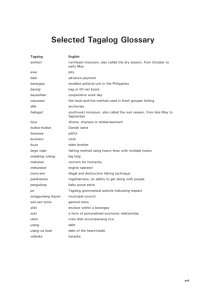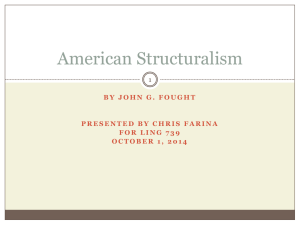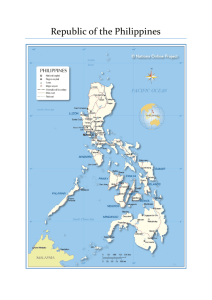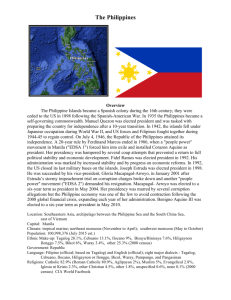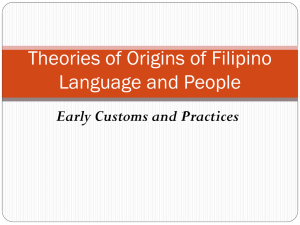Tagalog
advertisement
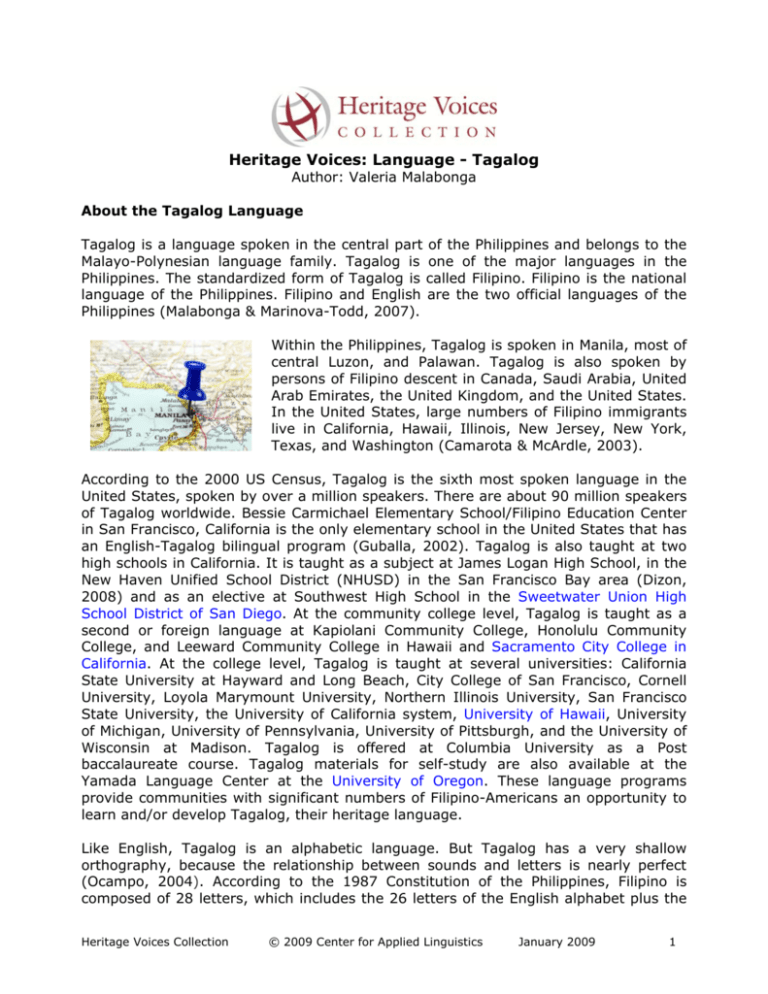
Heritage Voices: Language - Tagalog Author: Valeria Malabonga About the Tagalog Language Tagalog is a language spoken in the central part of the Philippines and belongs to the Malayo-Polynesian language family. Tagalog is one of the major languages in the Philippines. The standardized form of Tagalog is called Filipino. Filipino is the national language of the Philippines. Filipino and English are the two official languages of the Philippines (Malabonga & Marinova-Todd, 2007). Within the Philippines, Tagalog is spoken in Manila, most of central Luzon, and Palawan. Tagalog is also spoken by persons of Filipino descent in Canada, Saudi Arabia, United Arab Emirates, the United Kingdom, and the United States. In the United States, large numbers of Filipino immigrants live in California, Hawaii, Illinois, New Jersey, New York, Texas, and Washington (Camarota & McArdle, 2003). According to the 2000 US Census, Tagalog is the sixth most spoken language in the United States, spoken by over a million speakers. There are about 90 million speakers of Tagalog worldwide. Bessie Carmichael Elementary School/Filipino Education Center in San Francisco, California is the only elementary school in the United States that has an English-Tagalog bilingual program (Guballa, 2002). Tagalog is also taught at two high schools in California. It is taught as a subject at James Logan High School, in the New Haven Unified School District (NHUSD) in the San Francisco Bay area (Dizon, 2008) and as an elective at Southwest High School in the Sweetwater Union High School District of San Diego. At the community college level, Tagalog is taught as a second or foreign language at Kapiolani Community College, Honolulu Community College, and Leeward Community College in Hawaii and Sacramento City College in California. At the college level, Tagalog is taught at several universities: California State University at Hayward and Long Beach, City College of San Francisco, Cornell University, Loyola Marymount University, Northern Illinois University, San Francisco State University, the University of California system, University of Hawaii, University of Michigan, University of Pennsylvania, University of Pittsburgh, and the University of Wisconsin at Madison. Tagalog is offered at Columbia University as a Post baccalaureate course. Tagalog materials for self-study are also available at the Yamada Language Center at the University of Oregon. These language programs provide communities with significant numbers of Filipino-Americans an opportunity to learn and/or develop Tagalog, their heritage language. Like English, Tagalog is an alphabetic language. But Tagalog has a very shallow orthography, because the relationship between sounds and letters is nearly perfect (Ocampo, 2004). According to the 1987 Constitution of the Philippines, Filipino is composed of 28 letters, which includes the 26 letters of the English alphabet plus the Heritage Voices Collection © 2009 Center for Applied Linguistics January 2009 1 velar nasal ng (treated as a separate letter) and the Spanish ñ. However, actual use of the Filipino language still mostly follows the conventions of Tagalog; Filipino speakers tend to substitute Tagalog sounds and spelling for sounds and letters that do not natively exist in Tagalog (Malabonga & Marinova-Todd, 2007). Gordon (2005) states that there are eight major Tagalog dialects: Bataan, Batangas, Bulacan, Lubang, Manila, Marinduque, Tanay-Paete, and Tayabas-Quezon. Although their intonation and lexicon differ, these dialects are mutually intelligible. Marinduque is the most unique dialect, because its grammatical features are similar to Visayan languages such as Cebuano, most likely because it is adjacent to Visayanspeaking provinces such as Cebu (Nationmaster, 2008). Phonology Vowels Tagalog has five vowel sounds, a, e, i, o, u. All of them are short vowels. Because long vowels are nonexistent in Tagalog, native speakers of Tagalog are likely to pronounce long vowels in English as short vowels. Consonants Tagalog has 16 consonant sounds, including a glottal stop (Nationmaster, 2008). This is illustrated in the figure below. Bilabial Dental m n ŋ Voiceless p t k Voiced b d g Nasal Palatal Velar Glottal Plosive Fricative s h Flap Lateral Approximant l w j Source: http://www.nationmaster.com/encyclopedia/Tagalog-language#Consonants Heritage Voices Collection © 2009 Center for Applied Linguistics January 2009 2 The velar nasal ŋ can appear anywhere in a word, even at the beginning. The consonants /d/ and /r/ are allophones (Nationmaster, 2008). The glottal stop occurs where consonants may appear, except in consonant clusters. The glottal stop is necessary in differentiating the pronunciation of words with the same spelling, e.g., batá (child) and bata (robe) (Ramos & Cena, 1990). Stress Stress is usually phonemic and is on either of the last two syllables in root words (Himmelmann, 2000). Tagalog uses stress to differentiate meaning in words spelled the same, e.g., táyo (us) versus tayó (to stand) (Nationmaster, 2008). Also, the glottal stop within a word and the final glottal stop within phrases are usually dropped during rapid speech, e.g., saʔan in Saʔan ka pupunta? ‘Where are you going?’ so saʔan sounds like san (Ramos & Cena, 1990). There are five types of accentuation in Tagalog (Campbell, 2000): Malumay (Soft): Stress on the penultimate syllable Mabilís (Fast): Stress on the last syllable Malumí (Grave): Weak stress on the penultimate + grave on last syllable with glottal stop Maragsâ (Strong): Strong stress on the final syllable + glottal stop; this is indicated by the acute glottal accent mark (i.e., kudlít or vowel-modifying mark) Mariín (Heavy): Two syllables in the word are stressed Orthography The transparent orthography of the language is reflected in the ancient Tagalog writing system (called baybayin). Although four tribes in the Philippines still use a syllabary writing system similar to the ancient script, the majority of Filipinos write Tagalog in the Roman alphabet (Postma, 1971). The ancient Philippine script called baybayin (to spell) was syllabic and had 17 characters representing three vowels: a, e/i, o/u and 14 consonant syllables: ba, ka, da/ra, ga, ha, la, ma, na, nga, pa, sa, ta, wa, ya. Diacritics on top of the consonant represented the vowels e/i, whereas diacritics at the bottom represented the vowels o/u; final consonants were not indicated (Rubino, 2004). D and r had the same character. The transformation rule for d and r is as follows: letter d changes to r when in between two vowels, within the same word, or in between two words (Alejandro, 1947). The Commission on the Filipino Language (Komisyon sa Wikang Filipino) issued revised Tagalog spelling guidelines in 2001 (Revisyon ng Alfabeto at Patnubay sa Ispeling ng Wikang Filipino, Catacataca, 2005). These guidelines allowed the use of letters that did not originally exist in the Tagalog alphabet, i.e., c, f, j, ñ, q, v, x, and z. However, most Filipino writers still use the Tagalog alphabet and spelling for borrowed words (e.g., English conductor, Tagalog konduktor). Nonetheless, for languages deeply ingrained in Tagalog, such as Spanish, words often retain their original spelling but are pronounced the Tagalog way (e.g., Corazon as Corason) (de Guzman, 2001). Heritage Voices Collection © 2009 Center for Applied Linguistics January 2009 3 References Alejandro, R. (1947). A handbook of Tagalog grammar (with exercises). Manila: University Publishing. Camarota, S. A., & McArdle, N. (2003, September). Where immigrants live: An examination of state residency of the foreign born by country of origin. Washington, DC: Center for Immigration Studies. Available: http://www.cis.org/articles/2003/back1203.html Campbell, G. L. (2000). Compendium of the world’s languages: Vol. II. Ladakhi to Zuni (2nd ed.). London: Routledge. Dizon, J. P. (2008, August 24). Tagalog under attack. The YP4 blog. Retrieved from http://www.youngpeoplefor.org/blog/posts/3408 Gordon, R. G. (Ed.) (2005). Ethnologue: Languages of the world (15th ed.). Dallas, TX: Summer Institute of Linguistics. Available: http://www.ethnologue.com/print.asp Guballa, C. B. (2002, December 18). San Francisco school has Tagalog program. Philippine Daily Inquirer. Retrieved from http://www.inq7.net/globalnation/sec_fea/2003/dec/18-02.htm Himmelmann, N. P. (2000). Tagalog. In G. Booij, C. Lehmann, J. Mugdan, & S. Skopeteas (Eds.), Morphology: An International handbook on inflection and word formation (Vol. 2, pp. 1473–1490). Berlin: de Gruyter. Malabonga, V. & Marinova-Todd, S. (2007). Filipino speech acquisition. In McLeod, S. (Ed). The international guide to speech acquisition. (pp. 340-350). Independence, KY: Delmar Learning. Nationmaster. (2008). Encyclopedia: Tagalog language. Retrieved October 14, 2008, from http://www.nationmaster.com/encyclopedia/Tagalog-language. Northern Illinois University. (2005). Retrieved July 6, 2008 from http://www.seasite.niu.edu/Tagalog/Tagalog_mainpage.htm. Ocampo, D. (2004). Dyslexia in the Philippines. In I. Smythe, J. Everatt, & R. Slater (Eds.) International book of dyslexia: A guide to practice and resources. West Sussex, England: John Wiley. Postma, A. (1971). Contemporary Mangyan scripts. Philippine Journal of Linguistics, 2(1), 1–12. Ramos, T., & Cena, R. (1990). Modern Tagalog: Grammatical explanations and exercises for nonnative speakers. Honolulu: University of Hawaii Press. Retrieved January 27, 2008, from http://www.upm.edu.ph/camp/history.html. Heritage Voices Collection © 2009 Center for Applied Linguistics January 2009 4 Rubino, C. (2004). Tagalog-English/English-Tagalog standard dictionary (3rd printing). New York: Hippocrene Books. Wikipedia (2008). Tagalog language. Retrieved September 29, 2008, from http://en.wikipedia.org/wiki/Tagalog_language. About the Author: Valerie Malabonga Valerie Malabonga has a Ph.D. in Developmental Psychology and is a consultant at the Center for Applied Linguistics (CAL), in Washington, DC, where she was previously a staff member for 10 years. While Valerie was a CAL staff member, she conducted research assessing the language and literacy development of bilingual children and developed Filipino tests for children and adults for other organizations. Valerie is a member of a Filipino-American organization. She and her husband, Dan, are attempting to raise their 3 and 1/2 year-old son, Julius, as a FilipinoEnglish bilingual. Most of their relatives live in the Philippines, which they visit fairly regularly. Retaining the Filipino language is important to Valerie and her family, because it maintains their cultural identity and enhances their relationships with their Filipino relatives and friends in the United States and the Philippines. Valerie is also an avid reader and loves to read Filipino novels. Her son Julius recently discovered Filipino-English children’s books. The Heritage Voices Collection is designed to spotlight individual heritage language speakers and programs. The information presented does not necessarily represent the views of the Alliance for the Advancement of Heritage Languages or the Center for Applied Linguistics. Visit us online at www.cal.org/heritage Heritage Voices Collection © 2009 Center for Applied Linguistics January 2009 5

